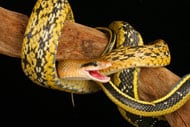Description:
The generic name of this species has only recently been changed from Elaphe. Wild collected individuals are often very defensive and may injure their snouts by striking against the glass of their terrarium. They will bite. Wild caught beauty snakes are also often heavily parasitized, dehydrated, emaciated and difficult to acclimate. Dehydrated snakes will have difficulty shedding their skin. Many will not feed readily. Captive bred examples, a much better choice, are seasonally available and pre-acclimated. Both normally colored examples and albinos are offered. At hatching, the slender beauty snake babies measure between 12 and 16 inches in length. They readily accept pinky mice and grow rapidly. Adult beauty snakes will eat breeder-sized mice and appropriately sized rats. This is an active, alert and shy snake. It should be provided with a large terrarium containing a hide-box and assorted visual barriers (such as cork bark or sterilized drift wood). One or two babies may be temporarily housed in a 10 gallon capacity terrarium. A pair of adults should be housed in a 50 to 125 gallon capacity terrarium. If provided with sturdy branches, these snakes will climb. If they have not been frightened, they will coil and rest on an elevated shelf or perch. Cypress, fir, aspen chips or bark shards are excellent choices for a substrate. A temperature of 68 degrees Fahrenheit at night and 76 to 82 degrees during the day is ideal for these snakes. A hot spot of 88 degrees should be provided for several hours a day. A large water bowl (kept scrupulously clean) should always be provided. The snakes will both drink, and if the receptacle is large enough, soak in the bowl. Winter dormancy seems necessary, or at least beneficial, to cycle this snake for breeding. It seems that the period of dormancy is more necessary for wild caught beauty snakes than for those that have been bred for several generations in captivity. Most breeders “hibernate†their beauty snakes in darkness for approximately 90 days at a temperature of 52 to 62 degrees. At the lower temperatures the snakes use less energy reserve. A clutch consists of 4 to 15 or more eggs. With a high incubation humidity and at a temperature of 83 to 84 degrees hatching occurs in 55 to 65 days. When generously fed the young grow quickly and can measure a yard or more in length in a year’s time.
Habitat:
A habitat generalist, the Taiwan beauty snake occurs in wooded areas, on agricultural lands and along water courses. It is an agile climber, but is often encountered in terrestrial habitats. It may seek shelter in piles of debris, vegetation or construction rubble.
Range:
This subspecies occurs only on Taiwan.
Scientific Name: Orthriophis taeniura friesei
Species Group: rat-snake
Family: Colubridae
Size: Commonly attains 6 feet in length; occasionally exceeds 8½ feet.
Level: intermediate
Weight:
Dangerous: No


